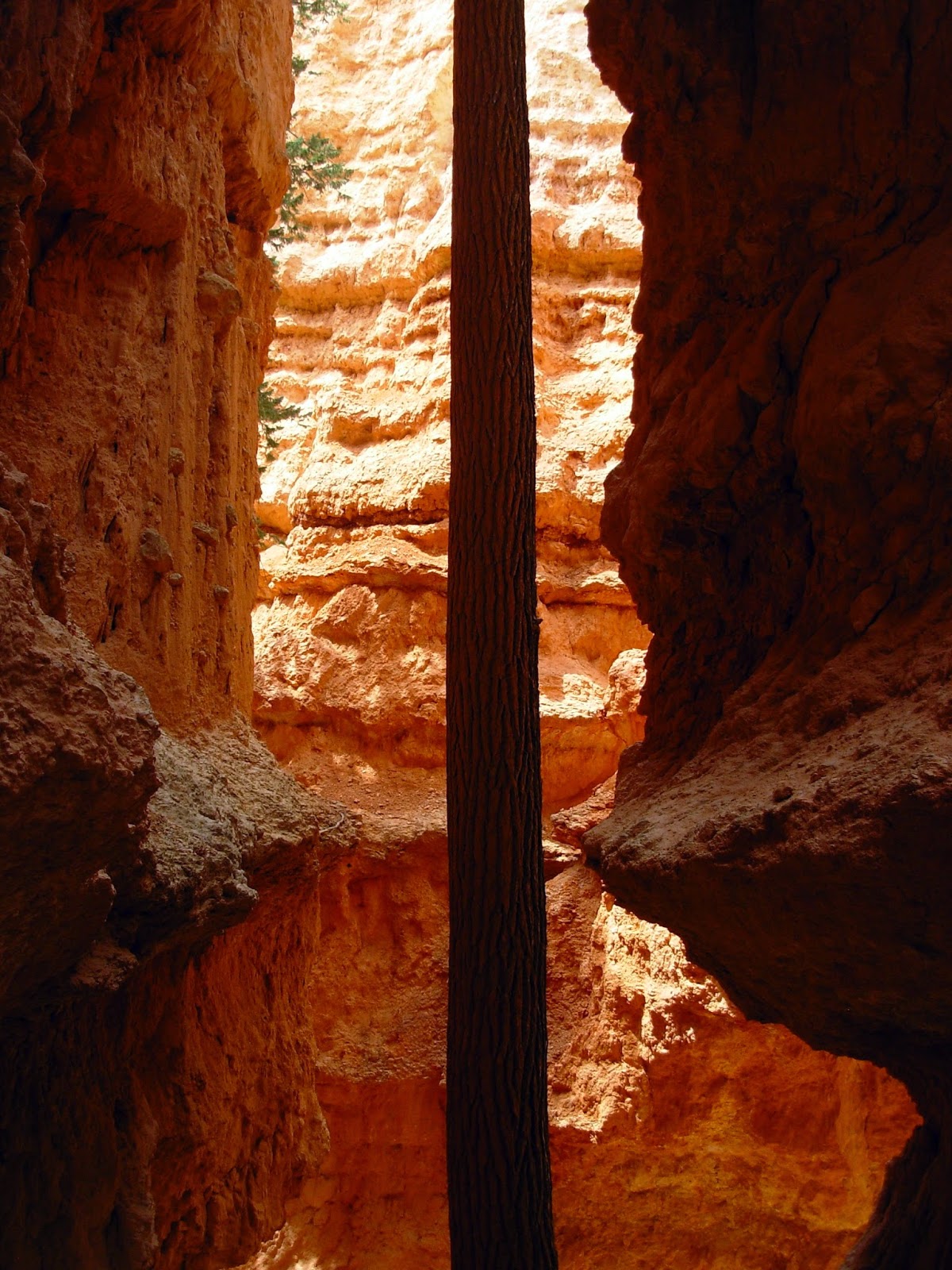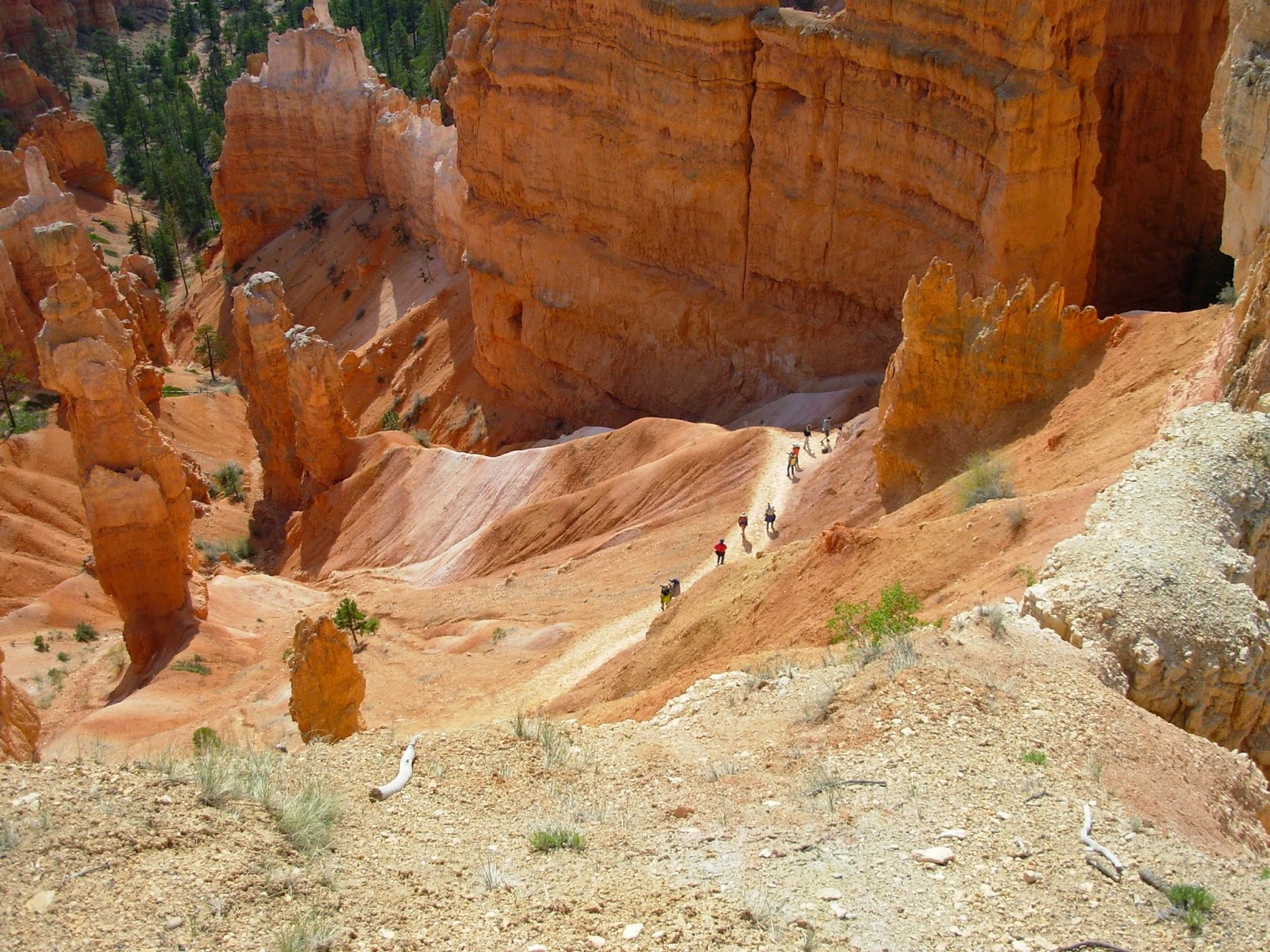Friday May 23
Woke up to wintery temps and a threat of rain. Though My roommates and I had considered doing a hike this morning, the less-than-ideal weather persuaded us to stay in instead. More games to play after all. And this time there were three of us. We played Radar's “Zombies,” which I quite enjoyed in spite of (or perhaps in part because of) the outrageously gory action cards. And later, two games of “Eight Minute Empire.” No wins for me today, but still a lot of fun. How fortunate that we all independently decided to bring diverse interactive entertainment.
Late afternoon. Temps were still in the low 40s, but with clouds occasionally parting and sun peeking through, we decided to drive to the southern end of the park and check out some of the main viewpoints. A first for Kara.

We found snow at Yovimpa—carpeting the bare ground in between low groves of Manzanita. The smell of brisk wet pine freshened the air. Colors more vivid in the dampness. Distant clouds drifted over the Grand Staircase, casting shadow over the gray cliffs and breaking periodically for the sun to illuminate the white cliffs—Molly's Nipple just peeking through. No wind. Stark silence in the occasional breaks in between arriving cars.
Looking Northeast at Rainbow Point we used a sign to identify main geological features along the horizon. The Aquarius and Table cliffs, 2000 feet higher than Bryce, were hidden beneath a blanket of clouds, but we could plainly see that there'd been snow there as well. Sunrise will be spectacular.
A bit more trash than normal to pick up on the way back to my car. I'm going to start bringing a plastic trash bag with me wherever I go.
Stopped at Natural Bridge (which is really more of an arch since it was not carved primarily by water) and Farview Point on the way home.
Pooled our food to make a big batch of nachos for a shared dinner. I made a killer pot of beef-pepper-tomato-bean sauce. Afterwards, we all went over to the historic cabins to join Rangers Sean and Don in watching a couple episodes of "Dr. Who." As it got darker, most of the clouds gave way to a clear Bryce night filled with stars. Don went out periodically to check on whether the much-anticipated first-ever Camelopardalid Meteor Shower was turning into anything worthwhile. As midnight approached the rest of us joined him in a walk down to the road where trees parted and a nice big swath of sky was visible. We had to put up with a surprising number of cars coming back in to the residential area—moved off to the side each time one passed. With all of us huddled heads down facing away from oncoming traffic, we must have been an odd sight.
No sign of the shower. Saw a few meteors, but most were coming from the south—the wrong direction for Camelopardalids. Meteor showers are named for the constellation from which they seem to radiate. Though likely to be seen anywhere in the sky, Perseids can be traced back to Perseus, Leonids to Leo, and so on. It's possible that our Camelopardalids may have shown up later—the best time to watch a shower is usually between midnight and the wee hours of morning when our side of the Earth is heading face on into whatever stream of cometary debris is responsible. Like driving a car through a cloud of insects, you're going to see more collisions if you're looking out the front windshield.
Even without the hoped for meteor storm, we still enjoyed the night. The Milky Way glowed—the outer edges of its summer dress slowly rising above the horizon. And as is usually the case, conversation under a sky of stars was free and varied and effortlessly amusing.
Saturday May 24
With morning skies socked in with high clouds, we decided that roving would be better than mediocre solar observing. It's Memorial Day weekend after all and the park is FULL. Parking is at a premium and those who choose not to take advantage of the free shuttle are—nine times out of ten—doomed to long waits and ultimate disappointment.

Clicker in hand (a little device that makes counting contacts simple and discreet) Radar and I took the shuttle to Sunset Point and headed down the Navajo Loop trail on our way to the newly opened Wall Street. One of the most iconic areas of the park, a series of steep switchbacks leads hikers down into a tall narrow slot canyon. Rockfalls here are common much of the year—when temperatures enable the freeze-thaw frost wedging process to hit its stride—and the trail is usually closed in winter and spring.

On our first roving experience, Kara and I encountered a few people who asked, “So...is Wall Street really closed...or is it only sort of closed? I mean, can't I just wander past the barrier? It's really fine right?” At the time our response was clear, “Yes, the trail is closed.” But we weren't yet sure how forceful we were supposed to be at that point. When I asked a Ranger about it later the response was, “INSTANT DECAPITATION. Yes. The trail is REALLY closed.” I used that line a time or two after that. Pretty effective.
That said. I'm glad Wall Street is now open. Though photographs never do these things justice, perhaps these few will help you imagine how unique this place is. In a busy park like Bryce, the only downside is that you usually have to share these special areas with a dozen other people at a time. All of them clamoring around and snapping pictures. One big clutter of humanity—and each of us seeking out an unobstructed moment or two to experience this grandeur on its own terms.
Coming out of Wall Street, Radar and I were trading ridiculous lines like, "The trail used to be closed because Wall Street crashed," Wall street has now recovered from the crash," and "It's a bear market."
I'll have to explain that last one a little.
There have been bear sightings in a few of the back country campsites this year. Always cause for vigilance and caution, but night before last one encounter got more serious. A couple was inside their tent when a bear came by and started snuffling and scratching around them. They yelled and screamed at the animal—as you're supposed to do—hoping all the noise would scare him off. It didn't work. He eventually left, but it was clear that it had been a close call. This bear is dangerously habituated to humans, and knows that finding humans means finding food. A few years ago I remember an instance where a habituated bear in Provo Canyon dragged a boy from his tent in the middle of the night and ate him. At the time I did a lot of hiking in the Wasatch on my own and the story terrified me. What would I do if I ran into a bear? That same story has been mentioned by the Rangers here, and serious action is being taken to avoid its repetition. As of today, all but a couple of the backcountry campsites and trails have been closed to both camping and hiking. I hear that Law Enforcement Rangers will issue citations for anyone disregarding the barriers, and if met with resistance, could go as far as arrest.
Spent my project time today updating my “Mapping the Moon” slides. If it passes muster, I may be given the opportunity to present it in front of a Bryce Canyon audience on one of our astronomy nights. Fingers crossed!
Our telescope viewing area was finally moved to the back parking lot tonight. That means we have a TON more room, and—at least when the light barrier fence arrives—less disruption by headlights coming and going. The evening started partly cloudy, but got worse and worse as our 9:30 start time approached. Still, we set everything up, got the big scopes collimated, and waited.

After the Ranger's Astro talks finished, the crowds started trickling in. At that point the only thing visible was Capella and a little corner of Auriga setting low in the west. All the planets were blocked and we weren't sure if the sky would end up cooperating at all. The trickle of people soon turned into a flood and I ran over to the massing crowd to hold them off as we waited for the last telescope operators to arrive. I gave them a quick rundown of how the evening would work (if we got any clear sky), and then simply asked, “does anyone have any questions about astronomy?” Just to keep the group occupied until we were ready to begin. “Where is the Milky Way?” “My phone's astronomy app never shows Mars in the right place.” What kind of telescopes are those?” “Can we see Saturn?” We had things to talk about.
Finally, our Rangers arrived. At almost the same time, the clouds began to break. We could see Jupiter, then Mars, then Saturn. And by the end of the evening, the entire sky was wide open and full of glittering stars. The air was surprisingly humid, and I had to keep wiping off my glasses and the telrad's plastic viewer. Still, I managed to show-and-tell a whole bunch of different objects. Starting with Jupiter, then Mizar & Alcor. A quick jump to Saturn, the Ring Nebula, and the Whirlpool Galaxy (I found it with no trouble at all...yay!). I rounded things off with the Sombrero, the Great Cluster in Hercules, the Beehive, the Stargate, and Albireo. For the last few intrepid observers, I brought out my wide field eyepiece and we gaped at the Leo Triplet (three galaxies close together underneath the hind leg of Leo the Lion), and M81 and M82 (two galaxies hanging out just off the scoop of the big dipper).
Navigating to so many objects over the course of one observing session was exhilarating. My fingers were freezing, and everything was fogging up, but my spirits were high and I felt like I could've stayed out all night.
Sunday May 25
Day off.
Hiked the Peekaboo Loop with Kara. My favorite Bryce Canyon hike so far. I took so many pictures my camera ran out of batteries. And still they don't come close to showing the reality of this place. This landscape is absolutely heart-wrenchingly beautiful. Overflowing with improbable colors, shapes, smells.
Down below the rim, at every turn is another vista of staggering scope and majesty, another tree coiled in motionless dance...
...another tiny desert flower springing up from the crumbling earth...
As we were standing in front of this towering “Wall of Windows,” I remarked to Kara that the view was so exquisite, it's hard to imagine that it's actually here all the time...that it's not some magical kingdom that will vanish tomorrow like a dream.
Those that come to Bryce for a quick look at the rim on their way to Zion are really missing out. I understand that sometimes that's the limit of what people can do these days. We all want to squeeze in as many places and activities into our preciously short vacation days as we can. See as much and do as much as is humanly possible. Get it all checked off the list, and then buy the t-shirt as proof we were there. But there's so much more to see in the changing light, the changing weather, and from slightly harder to reach or more out of the way vantage points. You're only going to appreciate these things by spending more quality time in ONE place. Slow time. Spontaneous time. Unstructured. Open. Quality wins over quantity in the long run.
I am SO grateful I've been given the opportunity to be here for an extended period. Just enough time to really let the place soak in.





















































